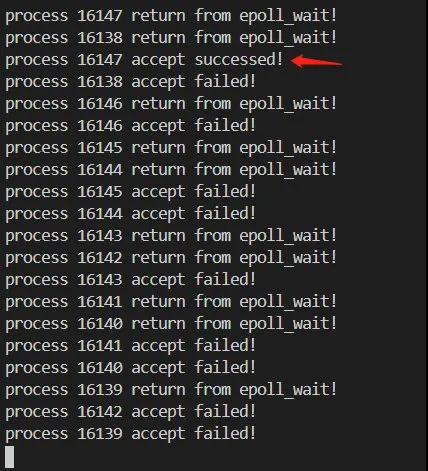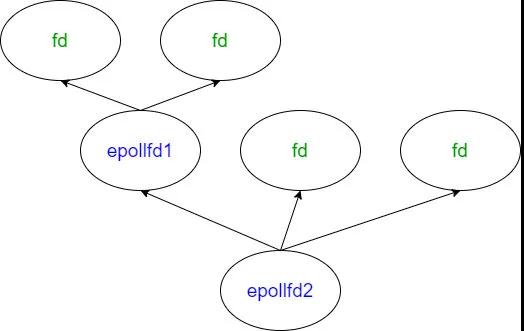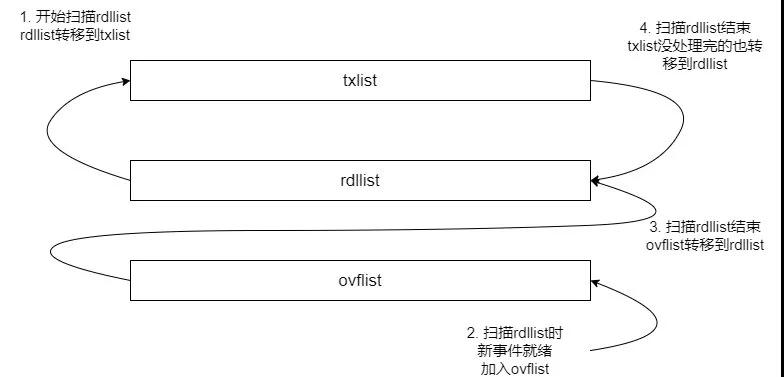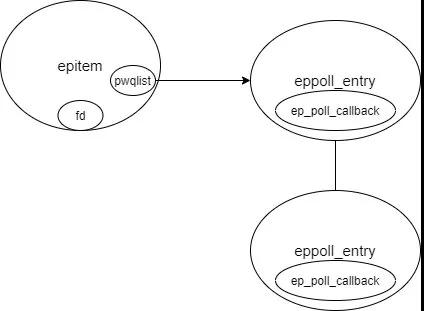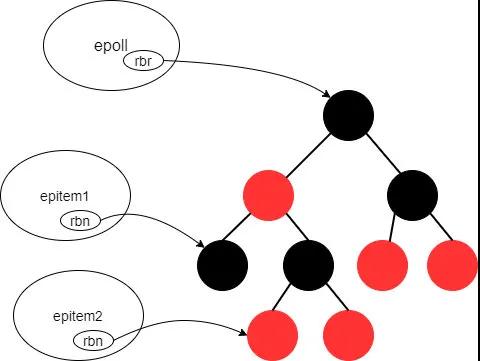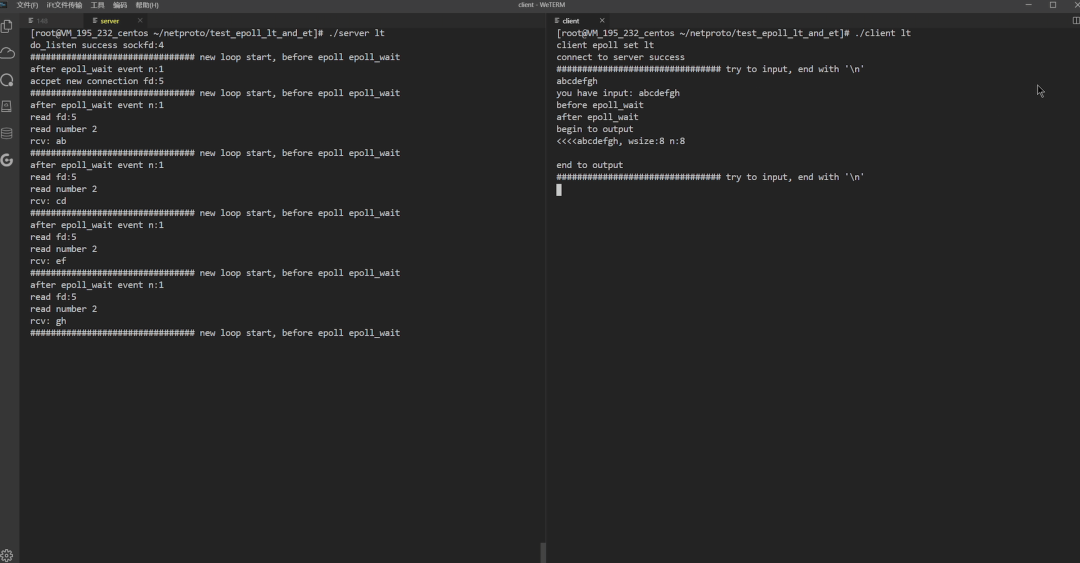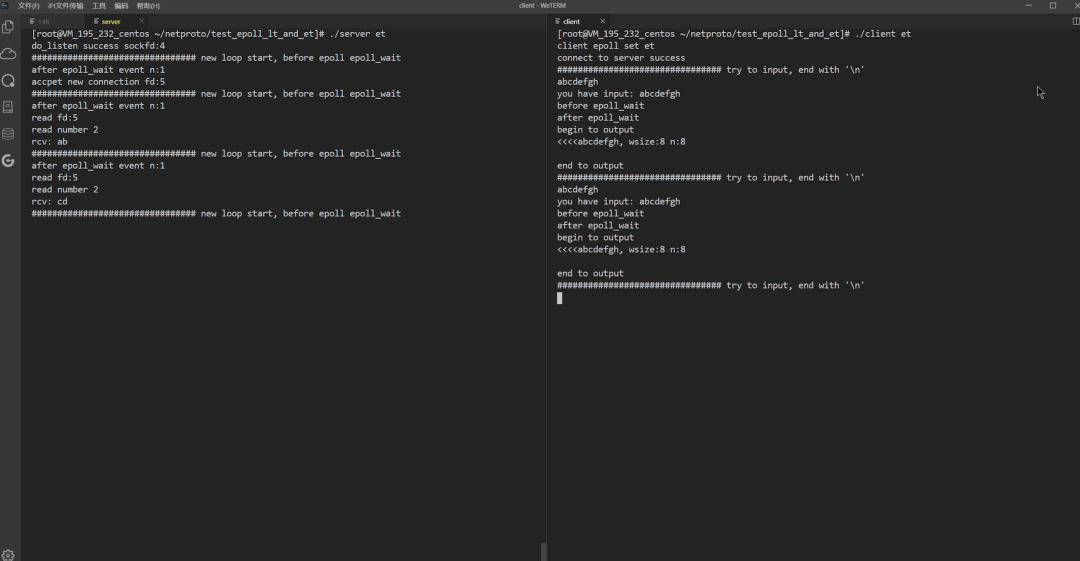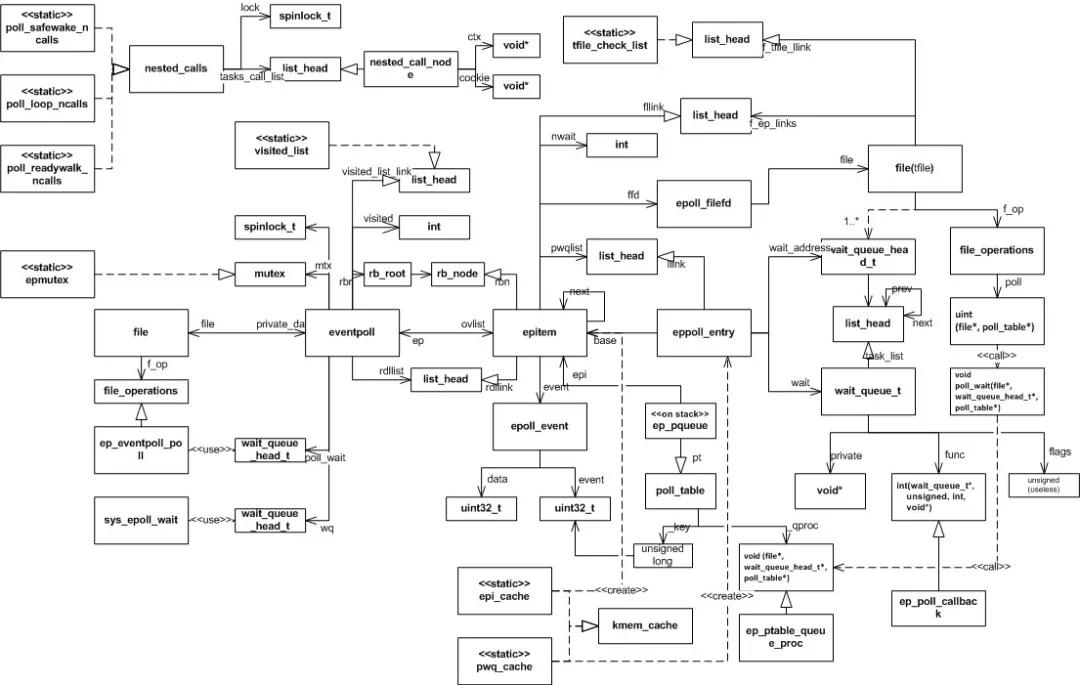十個問題理解Linux epoll工作原理
epoll 是 linux 特有的一個 I/O 事件通知機制。很久以來對 epoll 如何能夠高效處理數以百萬記的文件描述符很有興趣。近期學習、研究了 epoll 源碼,在這個過程中關于 epoll 數據結構和作者的實現思路產生出不少疑惑,在此總結為了 10 個問題并逐個加以解答和分析。本文基于的內核源碼版本是2.6.39 版本 。
Question 1:是否所有的文件類型都可以被 epoll 監視?
答案:不是。看下面這個實驗代碼:
- #include <stdio.h>
- #include <unistd.h>
- #include <sys/epoll.h>
- #include <stdlib.h>
- #include <sys/types.h>
- #include <sys/stat.h>
- #include <fcntl.h>
- #include <errno.h>
- #define MAX_EVENTS 1
- int main (void)
- {
- int epfd;
- epfd = epoll_create(100); /* 創建epoll實例,預計監聽100個fd */
- if (epfd < 0) {
- perror ("epoll_create");
- }
- struct epoll_event *events;
- int nr_events, i;
- events = malloc (sizeof (struct epoll_event) * MAX_EVENTS);
- if (!events) {
- perror("malloc");
- return 1;
- }
- /* 打開一個普通文本文件 */
- int target_fd = open ("./11.txt", O_RDONLY);
- printf("target_fd %d\n", target_fd);
- int target_listen_type = EPOLLIN;
- for (i = 0; i < 1; i++) {
- int ret;
- events[i].data.fd = target_fd; /* epoll調用返回后,返回給應用進程的fd號 */
- events[i].events = target_listen_type; /* 需要監聽的事件類型 */
- ret = epoll_ctl (epfd, EPOLL_CTL_ADD, target_fd, &events[i]); /* 注冊fd到epoll實例上 */
- if (ret) {
- printf("ret %d, errno %d\n", ret, errno);
- perror ("epoll_ctl");
- }
- }
- /* 應用進程阻塞在epoll上,超時時長置為-1表示一直等到有目標事件才會返回 */
- nr_events = epoll_wait(epfd, events, MAX_EVENTS, -1);
- if (nr_events < 0) {
- perror ("epoll_wait");
- free(events);
- return 1;
- }
- for (i = 0; i < nr_events; i++) {
- /* 打印出處于就緒狀態的fd及其事件 */
- printf("event=%d on fd=%d\n", events[i].events, events[i].data.fd);
- }
- free (events);
- close(epfd);
- return 0;
- }
編譯、運行上面的代碼,會打印出下列信息:
- gcc epoll_test.c -o epdemo
- ./epdemo
- target_fd 4
- ret -1, errno 1
- epoll_ctl: Operation not permitted
正常打開了"txt"文件 fd=4, 但調用 epoll_ctl 監視這個 fd 時卻 ret=-1 失敗了, 并且錯誤碼為 1,錯誤信息為"Operation not permitted"。錯誤碼指明這個 fd 不能夠被 epoll 監視。
那什么樣的 fd 才可以被 epoll 監視呢?
只有底層驅動實現了 file_operations 中 poll 函數的文件類型才可以被 epoll 監視!socket 類型的文件驅動是實現了 poll 函數的,因此才可以被 epoll 監視。struct file_operations 聲明位置是在 include/linux/fs.h 中。
Question 2:ep->wq 的作用是什么?
答案:wq 是一個等待隊列,用來保存對某一個 epoll 實例調用 epoll_wait()的所有進程。
一個進程調用 epoll_wait()后,如果當前還沒有任何事件發生,需要讓當前進程掛起等待(放到 ep->wq 里);當 epoll 實例監視的文件上有事件發生后,需要喚醒 ep->wq 上的進程去繼續執行用戶態的業務邏輯。之所以要用一個等待隊列來維護關注這個 epoll 的進程,是因為有時候調用 epoll_wait()的不只一個進程,當多個進程都在關注同一個 epoll 實例時,休眠的進程們通過這個等待隊列就可以逐個被喚醒了。
多個進程關注同一個 epoll 實例,那么有事件發生后先喚醒誰?后喚醒誰?還是一起全喚醒?這涉及到一個稱為“驚群效應”的問題。
Question 3:什么是 epoll 驚群?
答案:多個進程等待在 ep->wq 上,事件觸發后所有進程都被喚醒,但只有其中 1 個進程能夠成功繼續執行的現象。其他被白白喚起的進程等于做了無用功,可能會造成系統負載過高的問題。下面這段代碼能夠直觀感受什么是 epoll 驚群:
- #include <sys/types.h>
- #include <sys/socket.h>
- #include <sys/epoll.h>
- #include <netdb.h>
- #include <string.h>
- #include <stdio.h>
- #include <unistd.h>
- #include <fcntl.h>
- #include <stdlib.h>
- #include <errno.h>
- #include <sys/wait.h>
- #define PROCESS_NUM 10
- static int create_and_bind (char *port)
- {
- int fd = socket(PF_INET, SOCK_STREAM, 0);
- struct sockaddr_in serveraddr;
- serveraddr.sin_family = AF_INET;
- serveraddr.sin_addr.s_addr = htonl(INADDR_ANY);
- serveraddr.sin_port = htons(atoi(port));
- bind(fd, (struct sockaddr*)&serveraddr, sizeof(serveraddr));
- return fd;
- }
- static int make_socket_non_blocking (int sfd)
- {
- int flags, s;
- flags = fcntl (sfd, F_GETFL, 0);
- if (flags == -1)
- {
- perror ("fcntl");
- return -1;
- }
- flags |= O_NONBLOCK;
- s = fcntl (sfd, F_SETFL, flags);
- if (s == -1)
- {
- perror ("fcntl");
- return -1;
- }
- return 0;
- }
- #define MAXEVENTS 64
- int main (int argc, char *argv[])
- {
- int sfd, s;
- int efd;
- struct epoll_event event;
- struct epoll_event *events;
- sfd = create_and_bind("8001");
- if (sfd == -1)
- abort ();
- s = make_socket_non_blocking (sfd);
- if (s == -1)
- abort ();
- s = listen(sfd, SOMAXCONN);
- if (s == -1)
- {
- perror ("listen");
- abort ();
- }
- efd = epoll_create(MAXEVENTS);
- if (efd == -1)
- {
- perror("epoll_create");
- abort();
- }
- event.data.fd = sfd;
- //event.events = EPOLLIN | EPOLLET;
- event.events = EPOLLIN;
- s = epoll_ctl(efd, EPOLL_CTL_ADD, sfd, &event);
- if (s == -1)
- {
- perror("epoll_ctl");
- abort();
- }
- /* Buffer where events are returned */
- events = calloc(MAXEVENTS, sizeof event);
- int k;
- for(k = 0; k < PROCESS_NUM; k++)
- {
- int pid = fork();
- if(pid == 0)
- {
- /* The event loop */
- while (1)
- {
- int n, i;
- n = epoll_wait(efd, events, MAXEVENTS, -1);
- printf("process %d return from epoll_wait!\n", getpid());
- for (i = 0; i < n; i++)
- {
- if ((events[i].events & EPOLLERR) || (events[i].events & EPOLLHUP) || (!(events[i].events & EPOLLIN)))
- {
- /* An error has occured on this fd, or the socket is not ready for reading (why were we notified then?) */
- fprintf (stderr, "epoll error\n");
- close (events[i].data.fd);
- continue;
- }
- else if (sfd == events[i].data.fd)
- {
- /* We have a notification on the listening socket, which means one or more incoming connections. */
- struct sockaddr in_addr;
- socklen_t in_len;
- int infd;
- char hbuf[NI_MAXHOST], sbuf[NI_MAXSERV];
- in_len = sizeof in_addr;
- infd = accept(sfd, &in_addr, &in_len);
- if (infd == -1)
- {
- printf("process %d accept failed!\n", getpid());
- break;
- }
- printf("process %d accept successed!\n", getpid());
- /* Make the incoming socket non-blocking and add it to the list of fds to monitor. */
- close(infd);
- }
- }
- }
- }
- }
- int status;
- wait(&status);
- free (events);
- close (sfd);
- return EXIT_SUCCESS;
- }
將服務端的監聽 socket fd 加入到 epoll_wait 的監視集合中,這樣當有客戶端想要建立連接,就會事件觸發 epoll_wait 返回。此時如果 10 個進程同時在 epoll_wait 同一個 epoll 實例就出現了驚群效應。所有 10 個進程都被喚起,但只有一個能成功 accept。
為了解決 epoll 驚群,內核后續的高版本又提供了 EPOLLEXCLUSIVE 選項和 SO_REUSEPORT 選項,我個人理解兩種解決方案思路上的不同點在于:EPOLLEXCLUSIVE 是在喚起進程階段起作用,只喚起排在隊列最前面的 1 個進程;而 SO_REUSEPORT 是在分配連接時起作用,相當于每個進程自己都有一個獨立的 epoll 實例,內核來決策把連接分配給哪個 epoll。
Question 4:ep->poll_wait 的作用是什么?
答案:ep->poll_wait 是 epoll 實例中另一個等待隊列。當被監視的文件是一個 epoll 類型時,需要用這個等待隊列來處理遞歸喚醒。
在閱讀內核代碼過程中,ep->wq 還算挺好理解,但我發現伴隨著 ep->wq 喚醒, 還有一個 ep->poll_wait 的喚醒過程。比如下面這段代碼,在 eventpoll.c 中出現了很多次:
- /* If the file is already "ready" we drop it inside the ready list */
- if ((revents & event->events) && !ep_is_linked(&epi->rdllink)) {
- list_add_tail(&epi->rdllink, &ep->rdllist);
- /* Notify waiting tasks that events are available */
- if (waitqueue_active(&ep->wq))
- wake_up_locked(&ep->wq);
- if (waitqueue_active(&ep->poll_wait))
- pwake++;
- }
- spin_unlock_irqrestore(&ep->lock, flags);
- atomic_long_inc(&ep->user->epoll_watches);
- /* We have to call this outside the lock */
- if (pwake)
- ep_poll_safewake(&ep->poll_wait);
查閱很多資料后才搞明白其實 epoll 也是一種文件類型,其底層驅動也實現了 file_operations 中的 poll 函數,因此一個 epoll 類型的 fd 可以被其他 epoll 實例監視。而 epoll 類型的 fd 只會有“讀就緒”的事件。當 epoll 所監視的非 epoll 類型文件有“讀就緒”事件時,當前 epoll 也會進入“讀就緒”狀態。
因此如果一個 epoll 實例監視了另一個 epoll 就會出現遞歸。舉個例子,如圖所示:
epollfd1 監視了 2 個“非 epoll”類型的 fd
epollfd2 監視了 epollfd1 和 2 個“非 epoll”類型的 fd
如果 epollfd1 所監視的 2 個 fd 中有可讀事件觸發,fd 的 ep_poll_callback 回調函數會觸發將 fd 放到 epollfd1 的 rdllist 中。此時 epollfd1 本身的可讀事件也會觸發,就需要從 epollfd1 的 poll_wait 等待隊列中找到 epollfd2,調用 epollfd1 的 ep_poll_callback(將 epollfd1 放到 epollfd2 的 rdllist 中)。因此 ep->poll_wait 是用來處理 epoll 間嵌套監視的情況的。
Question 5:ep->rdllist 的作用是什么?
答案:epoll 實例中包含就緒事件的 fd 組成的鏈表。
通過掃描 ep->rdllist 鏈表,內核可以輕松獲取當前有事件觸發的 fd。而不是像 select()/poll() 那樣全量掃描所有被監視的 fd,再從中找出有事件就緒的。因此可以說這一點決定了 epoll 的性能是遠高于 select/poll 的。
看到這里你可能又產生了一個小小的疑問:為什么 epoll 中事件就緒的 fd 會“主動”跑到 rdllist 中去,而不用全量掃描就能找到它們呢? 這是因為每當調用 epoll_ctl 新增一個被監視的 fd 時,都會注冊一下這個 fd 的回調函數 ep_poll_callback, 當網卡收到數據包會觸發一個中斷,中斷處理函數再回調 ep_poll_callback 將這個 fd 所屬的“epitem”添加至 epoll 實例中的 rdllist 中。
Question 6:ep->ovflist 的作用是什么?
答案:在 rdllist 被占用時,用來在不持有 ep->lock 的情況下收集有就緒事件的 fd。
當 epoll 上已經有了一些就緒事件的時候,內核需要掃描 rdllist 將就緒的 fd 返回給用戶態。這一步通過 ep_scan_ready_list 函數來實現。其中 sproc 是一個回調函數(也就是 ep_send_events_proc 函數),來處理數據從內核態到用戶態的復制。
- /**
- * ep_scan_ready_list - Scans the ready list in a way that makes possible for the scan code, to call f_op->poll(). Also allows for O(NumReady) performance.
- * @ep: Pointer to the epoll private data structure.
- * @sproc: Pointer to the scan callback.
- * @priv: Private opaque data passed to the @sproc callback.
- * Returns: The same integer error code returned by the @sproc callback.
- */
- static int ep_scan_ready_list(struct eventpoll *ep,
- int (*sproc)(struct eventpoll *,
- struct list_head *, void *),
- void *priv)
由于 rdllist 鏈表業務非常繁忙(epoll 增加監視文件、修改監視文件、有事件觸發...等情況都需要操作 rdllist),所以在復制數據到用戶空間時,加了一個 ep->mtx 互斥鎖來保護 epoll 自身數據結構線程安全,此時其他執行流程里有爭搶 ep->mtx 的操作都會因命中 ep->mtx 進入休眠。
但加鎖期間很可能有新事件源源不斷地產生,進而調用 ep_poll_callback(ep_poll_callback 不用爭搶 ep->mtx 所以不會休眠),新觸發的事件需要一個地方來收集,不然就丟事件了。這個用來臨時收集新事件的鏈表就是 ovflist。我的理解是:引入 ovflist 后新產生的事件就不用因為想向 rdllist 里寫而去和 ep_send_events_proc 爭搶自旋鎖(ep->lock), 同時 ep_send_events_proc 也可以放心大膽地在無鎖(不持有 ep->lock)的情況下修改 rdllist。
看代碼時會發現,還有一個 txlist 鏈表,這個鏈表用來最后向用戶態復制數據,rdllist 要先把自己的數據全部轉移到 txlist,然后 rdllist 自己被清空。ep_send_events_proc 遍歷 txlist 處理向用戶空間復制,復制成功后如果是水平觸發(LT)還要把這個事件還回 rdllist,等待下一次 epoll_wait 來獲取它。
ovflist 上的 fd 會合入 rdllist 上等待下一次掃描;如果 txlist 上的 fd 沒有處理完,最后也會合入 rdllist。這 3 個鏈表的關系是這樣:
Question 7:epitem->pwqlist 隊列的作用是什么?
答案:用來保存這個 epitem 的 poll 等待隊列。
首先介紹下什么是 epitem。epitem 是 epoll 中很重要的一種數據結構, 是紅黑樹和 rdllist 的基本組成元素。需要監聽的文件和事件信息,都被包裝在 epitem 結構里。
- struct epitem {
- struct rb_node rbn; // 用于加入紅黑樹
- struct list_head rdllink; // 用于加入rdllist
- struct epoll_filefd ffd; // 包含被監視文件的文件指針和fd信息
- struct list_head pwqlist; // poll等待隊列
- struct eventpoll *ep; // 所屬的epoll實例
- struct epoll_event event; // 關注的事件
- /* 其他成員省略 */
- };
回憶一下上文說到,每當用戶調用 epoll_ctl()新增一個監視文件,都要給這個文件注冊一個回調函數 ep_poll_callback, 當網卡收到數據后軟中斷會調用這個 ep_poll_callback 把這個 epitem 加入到 ep->rdllist 中。
pwdlist 就是跟 ep_poll_callback 注冊相關的。
當調用 epoll_ctl()新增一個監視文件后,內核會為這個 epitem 創建一個 eppoll_entry 對象,通過 eppoll_entry->wait_queue_t->wait_queue_func_t 來設置 ep_poll_callback。pwdlist 為什么要做成一個隊列呢,直接設置成 eppoll_entry 對象不就行了嗎?實際上不同文件類型實現 file_operations->poll 用到等待隊列數量可能不同。雖然大多數都是 1 個,但也有例外。比如“scullpipe”類型的文件就用到了 2 個等待隊列。
pwqlist、epitem、fd、epoll_entry、ep_poll_callback 間的關系是這樣:
Question 8:epmutex、ep->mtx、ep->lock 3 把鎖的區別是?
答案:鎖的粒度和使用目的不同。
- epmutex 是一個全局互斥鎖,epoll 中一共只有 3 個地方用到這把鎖。分別是 ep_free() 銷毀一個 epoll 實例時、eventpoll_release_file() 清理從 epoll 中已經關閉的文件時、epoll_ctl() 時避免 epoll 間嵌套調用時形成死鎖。我的理解是 epmutex 的鎖粒度最大,用來處理跨 epoll 實例級別的同步操作。
- ep->mtx 是一個 epoll 內部的互斥鎖,在 ep_scan_ready_list() 掃描就緒列表、eventpoll_release_file() 中執行 ep_remove()刪除一個被監視文件、ep_loop_check_proc()檢查 epoll 是否有循環嵌套或過深嵌套、還有 epoll_ctl() 操作被監視文件增刪改等處有使用。可以看出上述的函數里都會涉及對 epoll 實例中 rdllist 或紅黑樹的訪問,因此我的理解是 ep->mtx 是一個 epoll 實例內的互斥鎖,用來保護 epoll 實例內部的數據結構的線程安全。
- ep->lock 是一個 epoll 實例內部的自旋鎖,用來保護 ep->rdllist 的線程安全。自旋鎖的特點是得不到鎖時不會引起進程休眠,所以在 ep_poll_callback 中只能使用 ep->lock,否則就會丟事件。
Question 9:epoll 使用紅黑樹的目的是什么?
答案:用來維護一個 epoll 實例中所有的 epitem。
用戶態調用 epoll_ctl()來操作 epoll 的監視文件時,需要增、刪、改、查等動作有著比較高的效率。尤其是當 epoll 監視的文件數量達到百萬級的時候,選用不同的數據結構帶來的效率差異可能非常大。
從時間(增、刪、改、查、按序遍歷)、空間(存儲空間大小、擴展性)等方面考量,紅黑樹都是非常優秀的數據結構(當然這以紅黑樹比較高的實現復雜度作為代價)。epoll 紅黑樹中的 epitem 是按什么順序組織的。閱讀代碼可以發現是先比較 2 個文件指針的地址大小,如果相同再比較文件 fd 的大小。
- /* Compare RB tree keys */
- static inline int ep_cmp_ffd(struct epoll_filefd *p1, struct epoll_filefd *p2)
- {
- return (p1->file > p2->file ? +1 : (p1->file < p2->file ? -1 : p1->fd - p2->fd));
- }
epoll、epitem、和紅黑樹間的組織關系是這樣:
Question 10:什么是水平觸發、邊緣觸發?
答案:水平觸發(LT)和邊緣觸發(ET)是 epoll_wait 的 2 種工作模式。水平觸發:關注點是數據(讀操作緩沖區不為空,寫操作緩沖區不為滿),epoll_wait 總會返回就緒。LT 是 epoll 的默認工作模式。
邊緣觸發:關注點是變化,只有監視的文件上有數據變化發生(讀操作關注有數據寫進緩沖區,寫操作關注數據從緩沖區取走),epoll_wait 才會返回。
看一個實驗 ,直觀感受下 2 種模式的區別, 客戶端都是輸入“abcdefgh” 8 個字符,服務端每次接收 2 個字符。
水平觸發時,客戶端輸入 8 個字符觸發了一次讀就緒事件,由于被監視文件上還有數據可讀故一直返回讀就緒,服務端 4 次循環每次都能取到 2 個字符,直到 8 個字符全部讀完。
邊緣觸發時,客戶端同樣輸入 8 個字符但服務端一次循環讀到 2 個字符后這個讀就緒事件就沒有了。等客戶端再輸入一個字符串后,服務端關注到了數據的“變化”繼續從緩沖區讀接下來的 2 個字符“c”和”d”。
小結
本文通過 10 個問題,其實也是從 10 個不同的視角去觀察 epoll 這間宏偉的殿堂。至此也基本介紹完了 epoll 從監視事件,到內部數據結構組織、事件處理,最后到 epoll_wait 返回的整體工作過程。最后附上一張 epoll 相關數據結構間的關系圖,在學習 epoll 過程中它曾解答了我心中不少的疑惑,我愿稱之為燈塔。
參考資料
Implementation of Epoll
Red-black Trees (rbtree) in Linux
What is the purpose of epoll's edge triggered option?
epoll 源碼分析(基于 linux-5.1.4)
epoll 實現原理
epoll (2) source code analysis
epoll 的內核實現
Linux Kernel Notes: epoll Implementation Principle
accept 與 epoll 驚群














